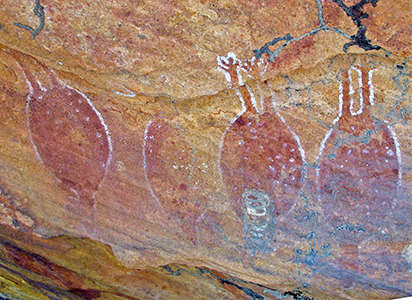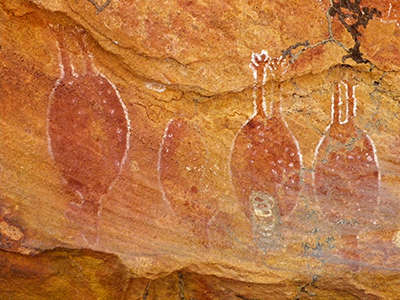Back to Don's Maps
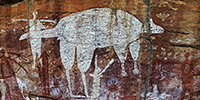 Back to Australian rock art and other Oz sites
Back to Australian rock art and other Oz sites Brady Creek and the nearby galleries - an Aboriginal Rock Art site in Northern Queensland

Painting of a man and woman copulating at the Honeymoon Corner Gallery, near Brady Creek, an Aboriginal Rock Art site in Northern Queensland
Photo: © Leo Dubal
The excellent photographs of Brady Creek and the Red Lady Galleries Aboriginal Rock Art site on this page are from Leo Dubal, www.archaeometry.org
The rock art of Brady Creek and the nearby galleries consists of both paintings and an important engraving. A painting of a man and woman copulating at the Honeymoon Corner Gallery is repeated in an engraving on a large smooth boulder in the bed of Brady Creek. In addition there are paintings of humans, yam figures, fruit bats roosting, a crocodile, a marsupial, negative hand prints, and spirit figures.
Low Brady Creek
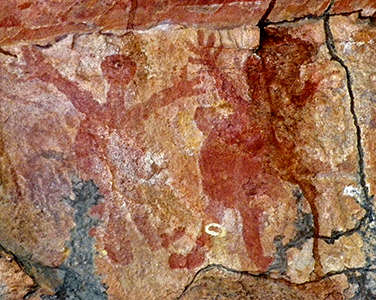
Male and female figures in red ochre, drawn with very fat fingers, spread out, with no regard for the normal anatomy of the hand, and with the arms raised. A white ellipse has been drawn on one of the female's legs.
Photo: © Leo Dubal
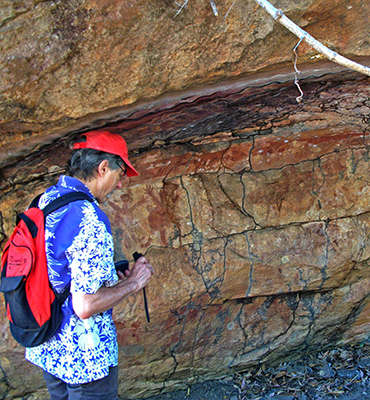
The panel is under an overhanging ledge.
Photo: © Leo Dubal
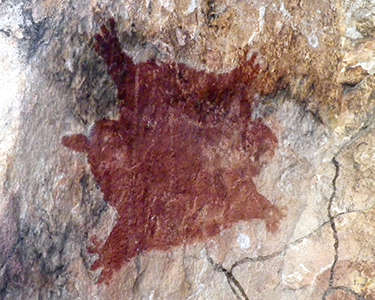
Although this has been interpreted as an echidna, it could also be a sugar glider.
Photo: © Leo Dubal
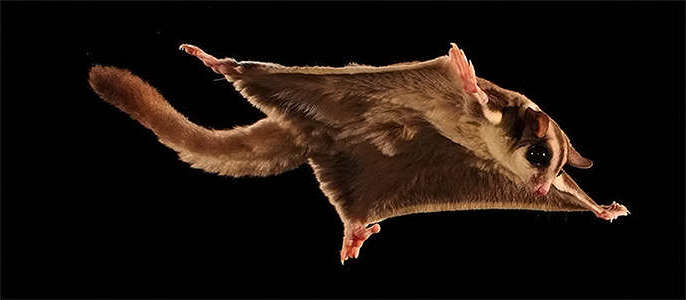
Sugar glider in flight.
The sugar glider is a small, omnivorous, arboreal gliding possum belonging to the marsupial infraclass. The common name refers to its preference for sugary nectarous foods and ability to glide through the air, much like a flying squirrel.
The scientific name, Petaurus breviceps, translates from Latin as 'short-headed rope-dancer', a reference to their canopy acrobatics.
The sugar glider is native to eastern and northern mainland Australia, and was introduced to Tasmania. It is also native to various islands in the region.
Photo: © Scott Linstead
Source: http://www.b2international.com/
Text: Adapted from Wikipedia
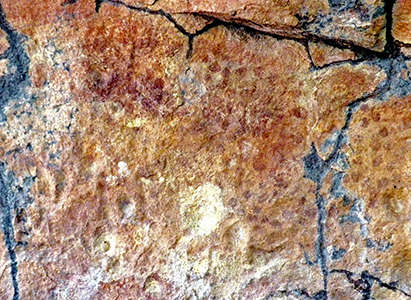
A group of hundreds of red ochre dots.
Photo: © Leo Dubal


Paintings, possibly engraved, of emu tracks.
These appear to be much older than most of the other paintings at this site.
Photo: © Leo Dubal

The two photographs above stitched into a panorama.
Photo: © Leo Dubal
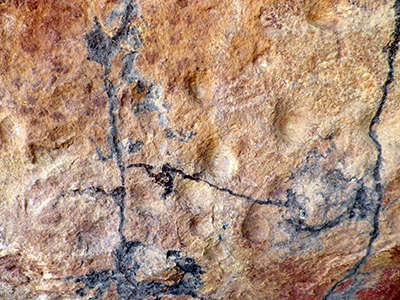
Cupules such as these are one of the most ubiquitous of all rock art forms, and they range from ancient to almost modern times. Estimating their age is very difficult indeed.
Photo: © Leo Dubal
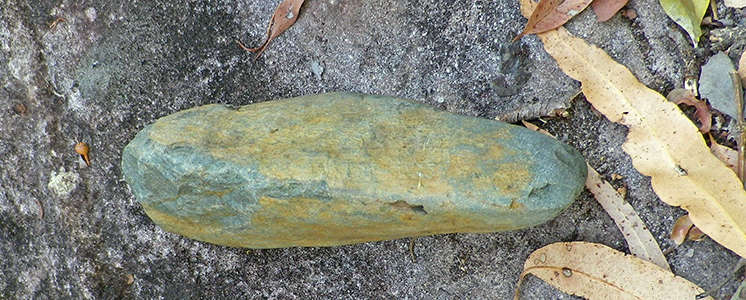
Stone axe with a ground edge.
Photo: © Leo Dubal
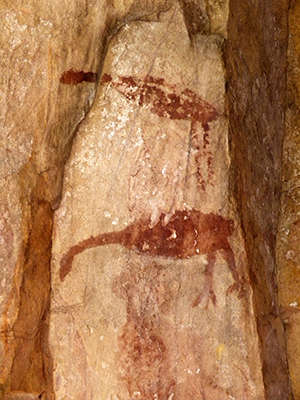
Emus, painted in red ochre. Emus were one of the most useful food sources in Australia before white settlement. Much effort was put into creating efficient hunting techniques.
Emus are curious birds, and some methods relied on this aspect of their behaviour. One method involved two hunters, both carrying large bundles of grass in front of them while approaching the emus.
Then one would lie down on the ground, and 'cycle' his legs in the air after dropping the grass bundle. The emus would approach this strange spectacle, and one or more would be speared by the second hunter.
Photo: © Leo Dubal
Death Adder Site
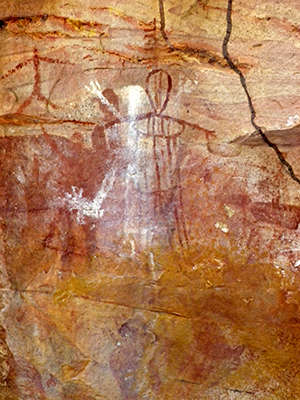
This is a complex panel, with, in red ochre, a stick figure at top left, below which is a hand stencil and a human figure with raised arms.
Overlying these is a smudged figure in white ochre, also overlying a female figure with a teardrop shaped head, with a body which is striped in red ochre.
Matt Trezise, the guide of Jowalbinna resort, an expert on the art of the area, writes:
The photograph is of a panel at the family campsite called 'Death Adder' (the low site on Brady Creek) - showing a white clay female figure, relatively recent and deteriorating, and beneath that, a very old linear figure in red ochre - the older figure is confidently identified as a female yam totemic ancestor, and is the work of the same artist who painted the male yam ancestor in the secluded, sacred, men-only site high on the escarpment, around the corner in Shepherd Creek. The recent white figure is likely to be a representation of the same ancestral female yam spirit.
Photo: © Leo Dubal
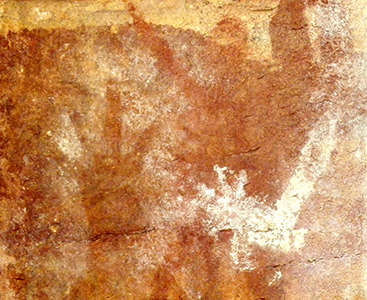
Close up of the hand stencil and human figure with raised arms.
Photo: © Leo Dubal
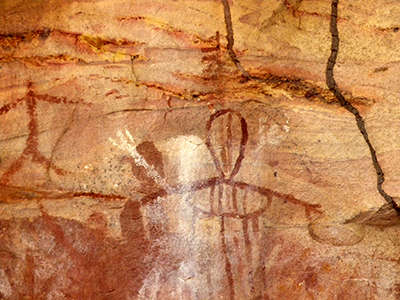
Close up of the head and torso of the female yam totemic ancestor.
Photo: © Leo Dubal
Crocodile Gallery

The main figure in this complex panel is a yam, with the characteristic lines radiating from one end. To the right is a crocodile, with a Quinkan figure with apparently three legs above that, and displaying the large ears of these spirit figures.
In three concentric arcs below that are what may be eels, and two groups of red dots. A male figure is to the right and below the three concentric arcs, and what may be a female spirit figure to the right of that.
Photo: © Leo Dubal
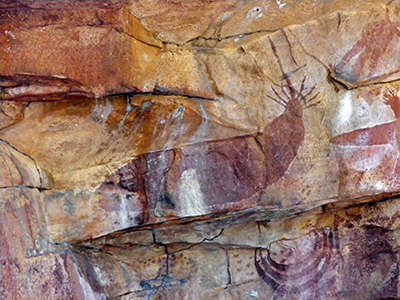
Close up of the central section of the photo above.
Photo: © Leo Dubal
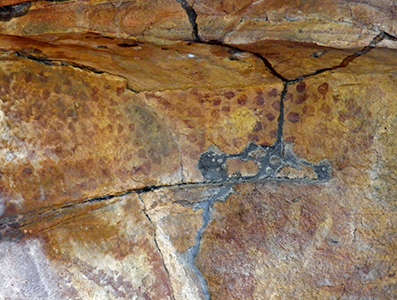
Close up of the two groups of red dots in the panel above.
Photo: © Leo Dubal
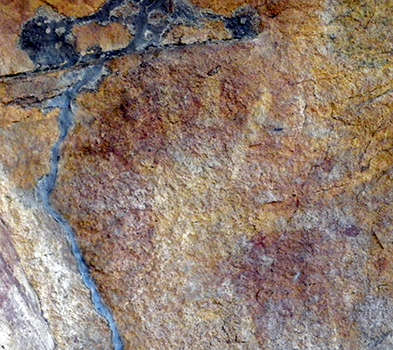
Below the two groups of red dots referred to above, there is this negative hand print done in red ochre.
Photo: © Leo Dubal
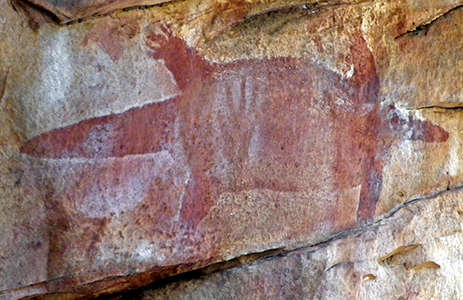
Crocodile to the right of the figure represented as a yam. The crocodile itself has several features of a yam, including its exaggerated width, and the treatment at the end of each of its legs, with radiating lines similar to that shown in yam representations.
Photo: © Leo Dubal
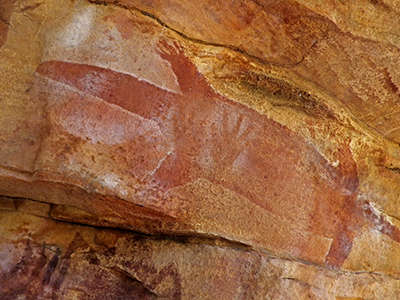
Another view of the crocodile from a different angle. Negative hand stencils in white ochre have been placed over the top of the original figure.
Photo: © Leo Dubal

Close up of the 'three legged' Quinkan figure. The central 'leg' is likely to represent a penis of exaggerated length and width.
Photo: © Leo Dubal
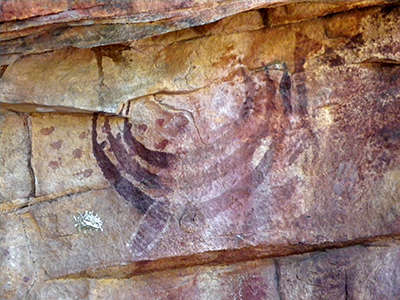
Close up of the three concentric arcs, possibly representing eels.
They overlie a series of faded dark red dots, with lower down, a possible yam painted over the outer of the three arcs.
Photo: © Leo Dubal
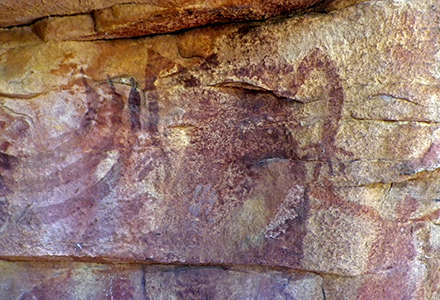
Quinkan figure to the right of the three concentric arcs, shown with elevated elbows, and the characteristic long earlobes, or triangular head, characteristic of this representation.
Photo: © Leo Dubal
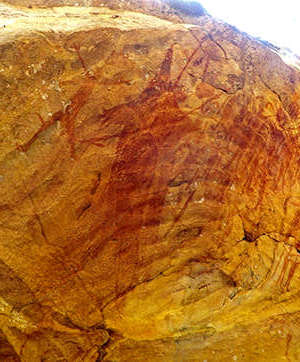
Close up of another, higher, section of the same panel. Note in particular the male figure to the top left, with a complex head dress and sticks coming out of his knees. These sticks may represent lightning, if the figure is analogous to figures at Kakadu.
The central figure is difficult to interpret, but has features similar to a crocodile.
Photo: © Leo Dubal

Another view of this panel.
There is a complex group of spirit figures to the right of the 'crocodile', one with what appears to be horns on the head, another having the typical fringe or halo of straight radiating lines coming from the head.
To the far right, and above, are two human figures. To the far right and below are a man and a woman, accompanied by what may be a spear beside the man and a coolamon beside the woman. The curved shape may also represent a fireplace.
A large male figure with extended fingers and with arms raised, as is usual, has been painted to the extreme right of this panel.
Photo: © Leo Dubal
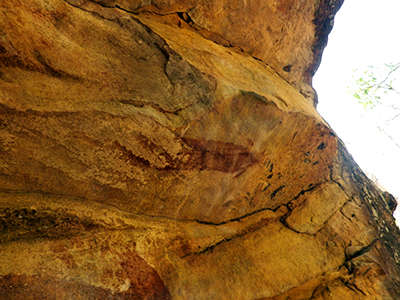
A yam figure on the lower right of the panel below a small ledge, disfigured by scraping or by white ochre.
The apparent yam figure at the foot of the image is one of the legs of the crocodile shown earlier.
Photo: © Leo Dubal
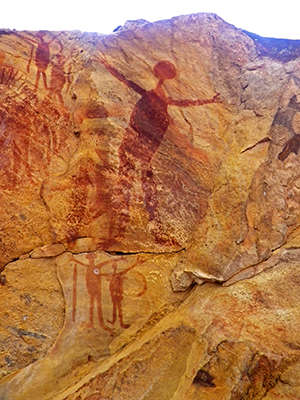
Image of the right hand end of the panel, showing two pairs of men and women with spear and coolamon, as well as a figure apparently leaning over to one side, with very long fingers.
Photo: © Leo Dubal
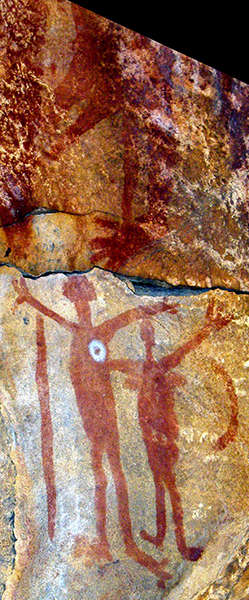
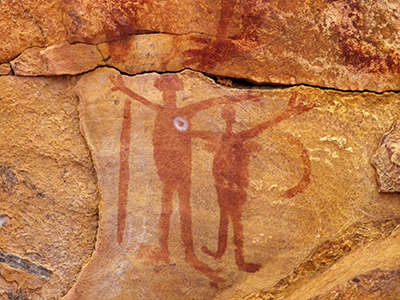
Close up of the man and woman, with possibly a spear and a coolamon or bowl. The curved shape may also represent a fireplace.
Photo: © Leo Dubal
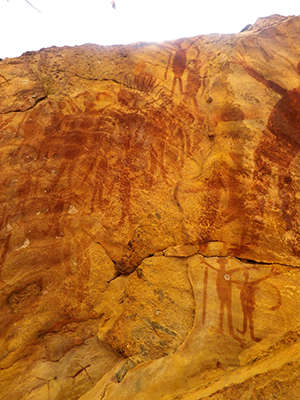
Central part of the panel, showing what may be a spirit figure with lines radiating from the head, the two pairs of male and female figures, and multiple other anthropomorphic figures one on top of the other.
Photo: © Leo Dubal
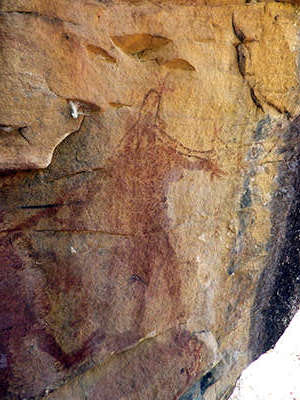
This figure, in dark red ochre, has a high head dress and may be female, judging by what may be a breast under the left arm (on the right of the image).
Painted over it in brown ochre is the crude outline of the head, arms, and part of the trunk of an anthropomorphic figure, with an elongated, ellipse shaped head.
Photo: © Leo Dubal
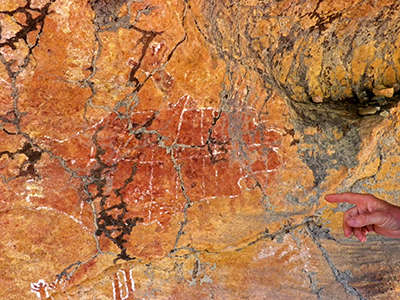
This shape appears often in the Laura region. It looks like a fish with a bifurcated tail, and a head which is in the shape of the roots of the yam.
The fish does not have the multiple dorsal fins usually shown when representing a Barramundi.
A lot of care went into this drawing. It has been outlined in white ochre, filled in with red ochre, and finally a white midline and crossing lines have been added. It is just above the representation of flying foxes hanging upside down.
Photo: © Leo Dubal
Flying Fox Gallery
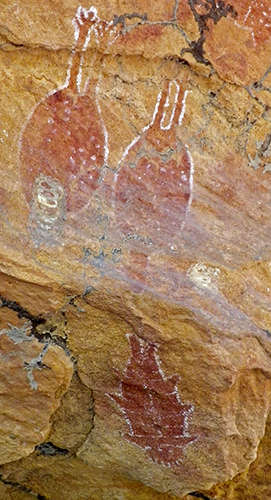
Two flying foxes or fruit bats resting at night, hanging upside down are shown in this image.
Below the flying foxes is a similar fish to that above, shown head downwards.
The fish has the same white outline, bifurcated tail, small fins, and division into sections by white ochre.
Photo: © Leo Dubal
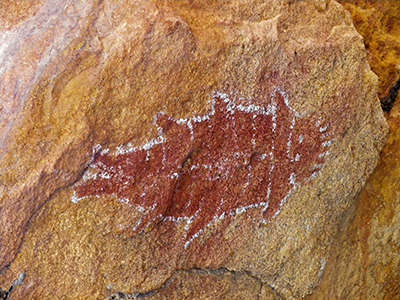
The fish above, rotated by 90°.
Photo: © Leo Dubal
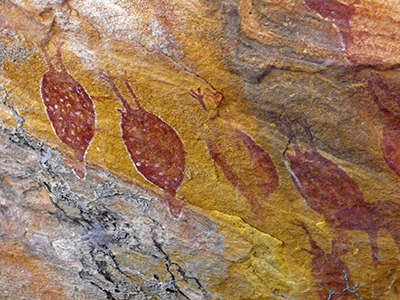
The two flying foxes shown with the fish, above, are part of this group.
Photo: © Leo Dubal
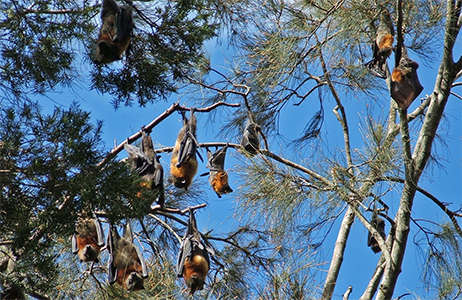
Flying foxes, in this case Peteropus poliocephalus, the grey-headed flying fox .
Photo: http://off.oatleypark.com/?page_id=285
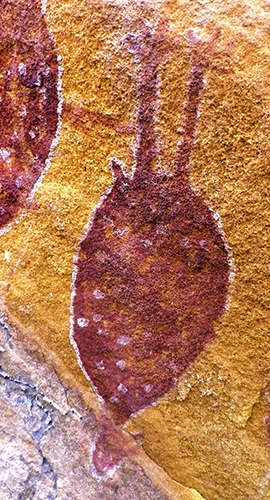
Close up of one of the flying fox paintings.
Photo: © Leo Dubal
Honeymoon Corner
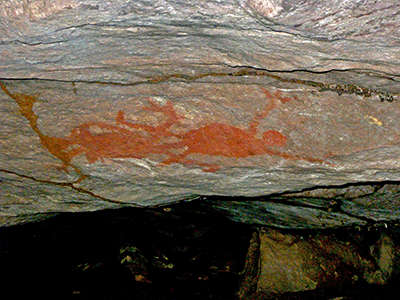
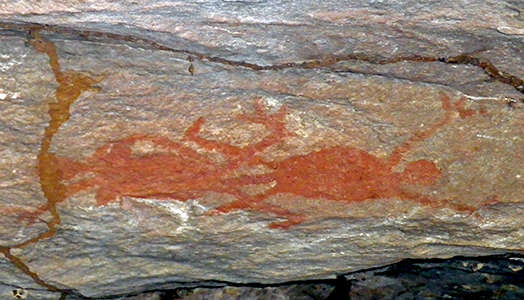
Man and woman copulating.
Photo: © Leo Dubal
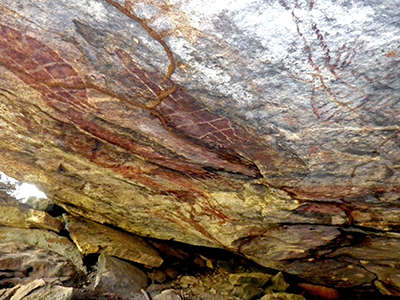
The roof of this shelter has been painted. The central figure appears to be a long necked turtle. The turtle has been outlined in white ochre, infilled in red ochre, and has then been decorated with white lines, with the sides of the neck continued through the length of the body, and three transverse lines added.
The turtle is easy to hunt, and was a welcome addition to the diet. The meat and eggs were a significant source of protein, and the carapace would have been useful for various tools and utensils.
Photo: © Leo Dubal
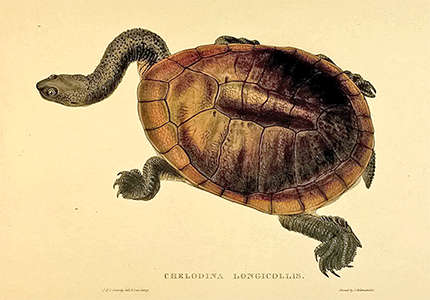
The eastern long-necked turtle, Chelodina longicollis, also known as the eastern snake-necked turtle, common snake-necked turtle or common long-necked turtle, has as its most distinctive feature its extremely long neck. In some cases, this turtle's neck can be as long as its carapace. It is a type of side-necked turtle, meaning that it bends its head sideways into its shell rather than pulling it directly back.
The eastern long-necked turtle also has powerful webbed feet for swimming, digging, and tearing apart prey. Its carapace (shell) is flattened, broad, and brown with black-edged scutes. On the underside plates (plastron) there are distinctive black lines or seams.
These turtles are found in the inland slow-moving freshwater habitats such as swamps, dams, and lakes of Australia, from northern Queensland to South Australia. They prefer a soft, sandy bottom and will bask on logs or rocks during the day. When it feels threatened, this turtle will emit an offensive smelling fluid from its musk glands. This trait gives the turtle one of its other common names, 'stinker.'
The eastern long-necked turtle is carnivorous, eating a variety of animals. This includes insects, worms, tadpoles, frogs, small fish, crustaceans, and molluscs.
In early summer, the female will lay between 2 and 10 eggs in the banks of her aquatic habitat. Three to five months later the hatchlings break out of their shells. These young turtles often fall prey to predators such as fish and birds. Females will lay 1 to 3 clutches of eggs per year.
Photo: Public Domain
Source: Sowerby and Lear (1872)
Text: Wikipedia

This is a most unusual painting, since it appears to depict a shrub or tree. Vegetation is rarely a subject of aboriginal wall art. It has been partially outlined in white ochre, and infilled in mustard coloured ochre.
Photo: © Leo Dubal
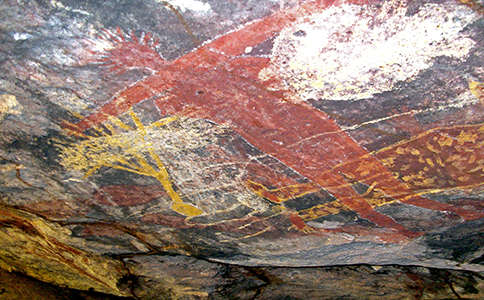
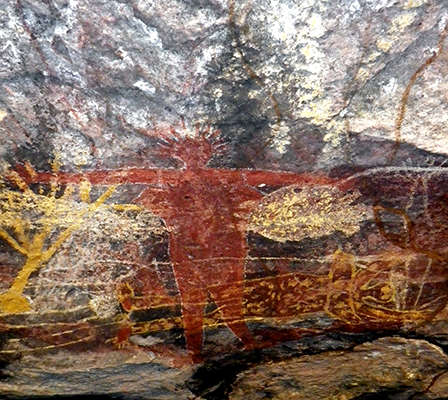
The panel, of which the tree above is a part, is complex. It includes the tree, a female spirit figure with rayed hair or head dress outlined in white and infilled in red, and another female spirit figure at 90° to the first and overlaying it, with splotches of yellow ochre indicating that it is not an ordinary human being. Note that the breasts have been outined in full, not just where they project from the body, which is more usual in this area.
A short necked turtle, possibly the Saw-shelled turtle, Wollumbinia latisternum, has been outlined and infilled in white ochre and then coated with a layer of yellow ochre, which has partially flaked off.
Photo: © Leo Dubal
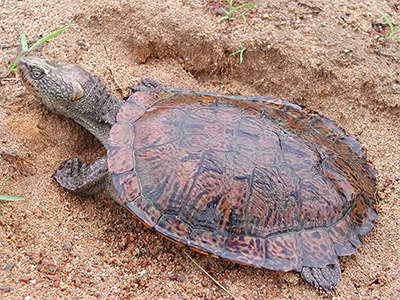
Saw-shelled turtle, Wollumbinia latisternum. The Australian saw shelled turtles, Myuchelys, are a genus of turtles in the family Chelidae. They inhabit the headwaters and tributaries of rivers within their range and this led to the name Myuchelys, which is formed from the Aboriginal words Myuna meaning clear water and chelys meaning turtle. They have a short neck and the intergular scute completely separates the gular scutes.
Photo: © Craig Latta
Permission: 'I am happy for my image of the Australian Saw-shelled turtle to be used under a 'free licence' on Wikipedia.'
Text: Wikipedia

Distribution of the Saw-shelled turtle, Wollumbinia latisternum, average length 28 cm.
Photo: © 2008 - 2014 AROD.com.au
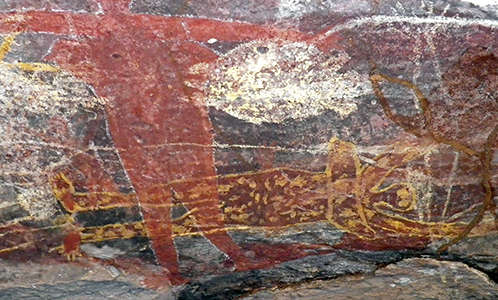
Close up of the horizontal spirit woman, and the short necked tortoise.
The spirit woman has been outlined in yellow ochre, has her arms raised, and has been infilled with red ochre. The artist has then added yellow ochre in splotches over most of the figure.
Note also the outline of a yam in white ochre on the right of this image.
Photo: © Leo Dubal
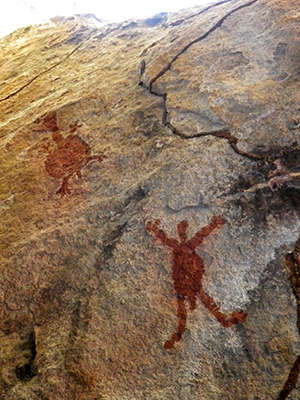
Long necked turtle left, human male right, completed in red ochre. The turtle has been outlined in white ochre.
Photo: © Leo Dubal
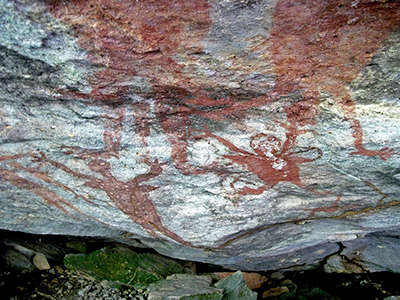
This is another complex panel, dominated by a female figure in dark red ochre, but with carefully executed polka dots all over the body. The figure has eyes indicated, and just three fingers on each hand.
To the right is a female spirit figure, with squat body and long but twisted arms and legs.
Photo: © Leo Dubal
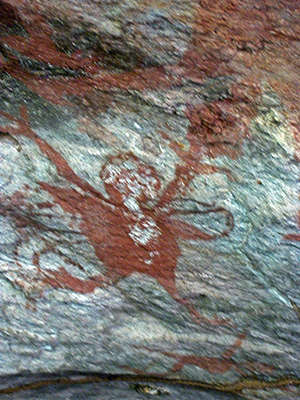
Spirit figure from the panel above.
Photo: © Leo Dubal
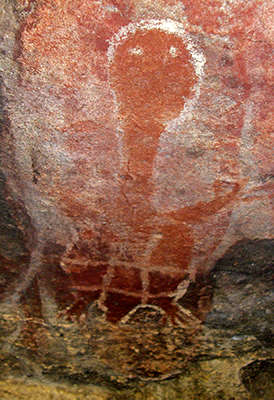
Painting of a long necked turtle, with the head in the image exaggerated in size because of the angle at which the photo was taken.
Outlined in white ochre, infilled with red ochre. Eyes are shown as white dots, and the body has been divided into nine segments by four lines.
Photo: © Leo Dubal
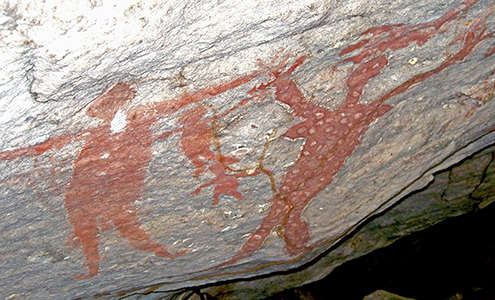
Another view of the dotted female figure, which has been outlined in white ochre.
Beside her on the left is a male figure, outlined in a thin white line, with a white dividing line at the pelvis, and with two smaller figures, possibly children, between these two.
Photo: © Leo Dubal
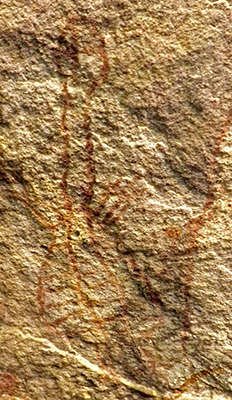
Long Necked Turtle outlined in red/brown ochre.
Photo: © Leo Dubal
Echidna Gallery
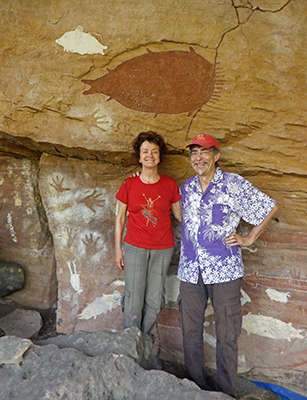
This panel shows a large and carefully drawn fish in red ochre, a white fish above it, and a large broad panel below that which includes several hand stencils in white ochre, and severall other images as shown in the images below.
Photo: © Leo Dubal
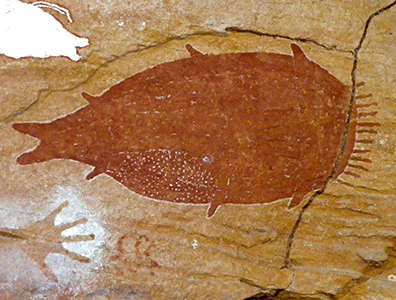
This is a very clearly delineated fish, outlined in white ochre and infilled in red. Dots have been arranged on the back ventral surface, possibly indicating fish roe. The fish has three sets of fins on its dorsal and ventral edges, and has the lines at the head which denote a yam.
A white hand stencil has been placed beneath the fish.
Photo: © Leo Dubal

This lower panel shows:
• Woman with two children and a coolamon
• Five or more hand stencils
• Inverted marsupial
• White ochre fish/yam
• White ochre fish, possibly barramundi
• Multi coloured male, shown horizontally with arms raised
• Three freshwater sawfish
• Two eels, with a white ochre female with spread arms and legs in front of one of them
• White echidna
Photo: © Leo Dubal
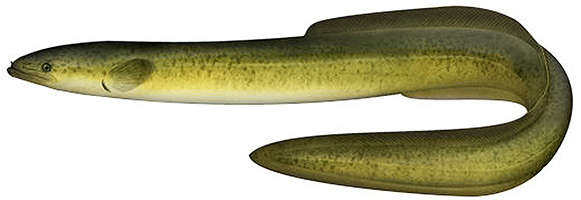
The Longfinned eel, Anguilla reinhardtii, is found in freshwater rivers, streams, dams, lagoons and lakes on the coastal side of the Great Dividing Range, from Cape York in northern Queensland southwards through NSW into Victoria and Tasmania. Reaches a maximum length of approximately 1.7 metres and 22 kg in weight. Commonly found up to 1 metre in length.
Longfinned eels have an olive-green, heavily mottled back and sides and a silvery-white to pale yellow belly. They are the largest freshwater eel in Australia, with females growing much larger than males. It is a good recreational species because of its large size and strength. Commonly caught at night on baited hooks, particularly pieces of fish and earthworms.
Photo and text: http://www.dpi.nsw.gov.au/fisheries/recreational/saltwater/sw-species/long-finned-eel
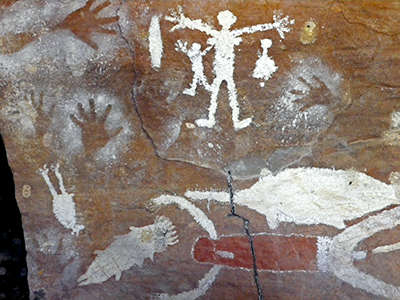
This complex panel includes what appears to be a family group - a small painting in white ochre of a woman, with natural proportions, accompanied by what may be two children, one on each side, as well as a what may represent a coolamon.
Five hand stencils in white ochre are visible in this image, as well as an upside down kangaroo, a white fish/yam, again with the divisions seen in some of the images above, as well as a man with no neck, with head and torso in red ochre, arms, legs, penis and what might be a waist band in white ochre, with what may represent a pendant around his neck.
Above him is a freshwater sawfish in white ochre.
Photo: © Leo Dubal
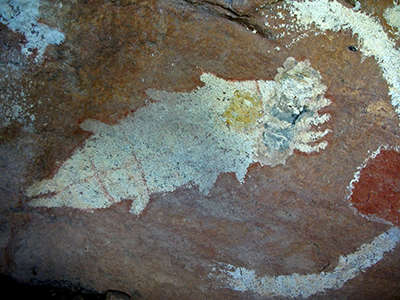
Closeup of the fish in the form of a yam shown above.
Photo: © Leo Dubal
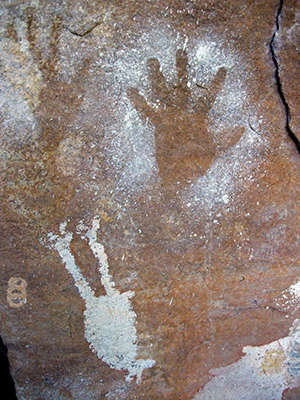
Close up of the inverted kangaroo, which may be a Whiptail or Pretty Face Wallaby, and two negative hand prints in white ochre.
Photo: © Leo Dubal
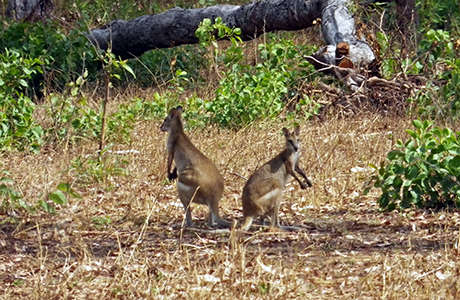
Macropus parryi - Whiptail or Pretty Face wallabies in the Brady Creek area. Their habitat is undulating or hilly terrain near the coast with eucalypt open forest or woodland with a grassy understorey.
Their present distribution consists of discontinuous populations from Cooktown south to the north-eastern NSW border; from coastal areas to the western edge of the Great Dividing Range.
Photo: © Leo Dubal
Text: adapted from http://www.wildlife.org.au/wildlife/speciesprofile/mammals/whiptail_wallaby.html
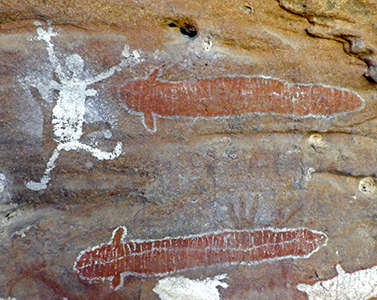
Two eels outlined in red ochre, infilled with dark red ochre, and decorated with a median line and many crossing lines, possibly in this case representing the skeleton.
Aborigines used long cylindrical fibre traps, specially made for eels, to catch them, and/or speared them. In Victoria aborigines constructed huge, elaborate canals and stone traps in an eel farming operation which allowed them to be sedentary, living in houses with stone foundations, trading smoked eels over large distances. These eel farms existed for 8 000 years, up until white settlement.
On the left of the image is a white ochre human female, overlying a white ochre hand stencil, with another hand stencil behind the lower eel.
Photo: © Leo Dubal
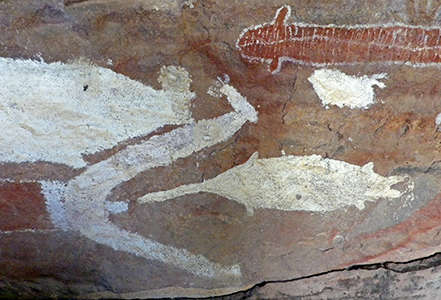
Surely the juxtaposition of the freshwater sawfish beak and the human's penis cannot be accidental?
It might be that the sawfish had spiritual meaning because of the penis like extension to its beak.
Photo: © Leo Dubal
Human Footprint Gallery
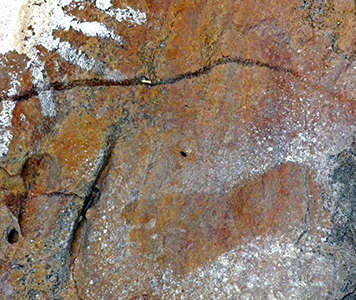
This negative stencil of a foot must have been difficult to produce!
There are very few stencils of the foot, for obvious reasons.
This one is low down on the wall, below what is probably an echidna done in white ochre.
Photo: © Leo Dubal
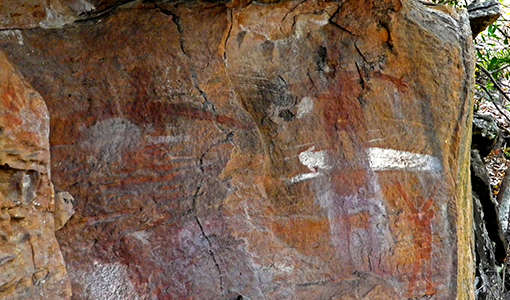
Eel in white ochre at the middle right, with a human female with upraised arms on the lower right, outlined in white and infilled in red ochre. Overlying the white eel is a larger female completed in red ochre, much faded but originally outlined in white.
On the left is a male figure in red ochre, almost obliterated by time and what may have been erosion of the surface.
Photo: © Leo Dubal
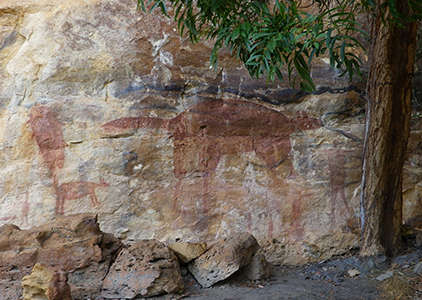
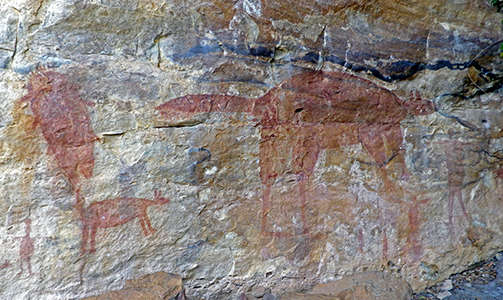
This large panel shows a large and a small dingo, with a vertically oriented red fish with a yam head and forked tail.
Below and to the left is what may be a long necked spirit figure, and to the right of the large dingo on the right are two small human figures with outstretched arms, as well as two very small figures to the left of these two.
Photo: © Leo Dubal
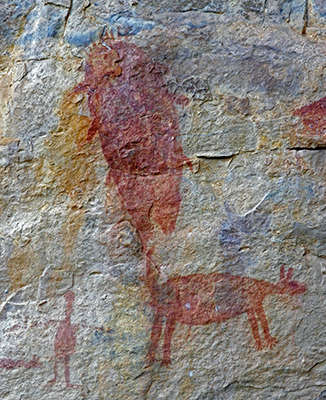
Close up of the fish, small dingo, and small spirit figure on the left of the panel.
Photo: © Leo Dubal
Red Lady Gallery
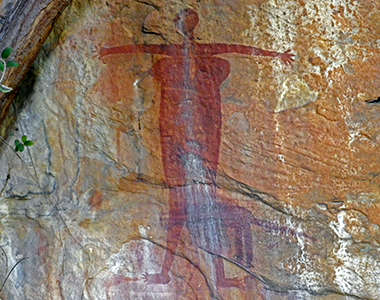
This is the 'Red Lady' that the gallery is named after.
The figure is outlined in white, and infilled in red. The hands and feet are carefully drawn, although there are only four toes on the left foot. The breasts are treated as a separate structural unit, and the arms are joined directly to the neck, so that there are no shoulders.
The white marks on the figure appear to be from natural seepage and staining.
Partially obscured at her legs is a darker red dingo, outlined in white, though much faded.
Photo: © Leo Dubal
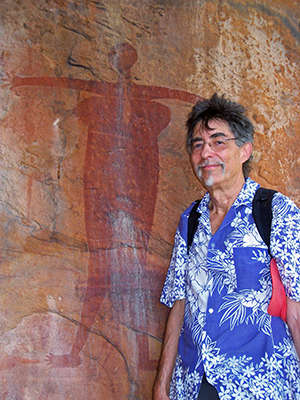
M. Leo Dubai standing in front of the 'Red Lady' to give scale.
Photo: © Leo Dubal
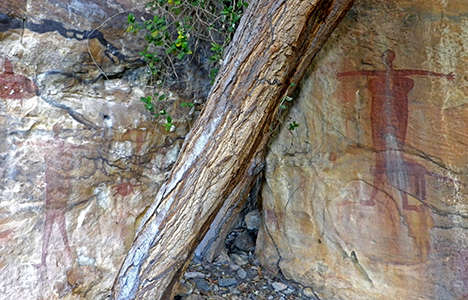
A more distant shot which shows the layout of the gallery well. To the left is a panel with a human figure in red, and a small globular figure with four appendages and what may be a small head.
Photo: © Leo Dubal
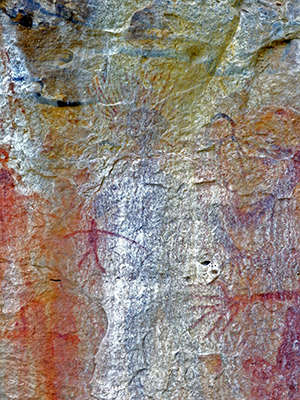
The head of a very large spirit figure in the centre, with the head and rays coming from the head in red. Apparently this is overlain by another figure in a much darker colour, with truncated arms, and overlain with a white wash.
To the right is a similar situation, with the head and rays from the head of another spirit figure completed in a pale brown/yellow overlain by the outline in dark brown of another figure.
There is the small outline of a human with one very long left arm overlying the white wash of the central figure.
Date stamp 2:18 am
Photo: © Leo Dubal
Text below (my bold) adapted from http://www.thefreelibrary.com/AMS+dating+of+rock+art+in+the+Laura+Region,+Cape+York+Peninsula,...-a0137718819
Red Lady art site is located at Jowalbinna in the south-west of the region, at the foot of a high escarpment, which overlooks a sheer drop to the junction of Shepherd and Brady Creeks. Like the Ancestral Figures site at the Laura River, Red Lady has difficult access, little or no overhang, and is unsuitable as a campsite. The few 'fresh' looking paintings at the site are set apart from a centrally placed group of imposing, weathered anthropomorphs which are faintly visible under a milky coating of silica. A particularly imposing figure of the group is a female anthropomorph with a rayed headdress. A smaller figure alongside has large, claw-like hands.
The silica film that covers the anthropomorphs is exfoliating in many areas. Four minute samples were removed from exfoliating crust covering the remains of one of the anthropomorphs. Micro-organic matter encapsulated in silica skin of a layer of crust immediately above the red paint of sample RL1.3 (7.5mg of powder) gave less than 0.01 mg of graphite that was dated at 7230 ± 750 BP (OZA-411). This result is similar to the age determination for silica skin in association with Ancestral paintings at Split Rock. The similarity in ages for silica analysed at these two sites probably reflects the cessation of silica skin formation across the region rather than coincidence in the painting events.

Spirit figure with greatly exaggerated fingers. The right hand of this figure may be seen in the image above.
Photo: © Leo Dubal
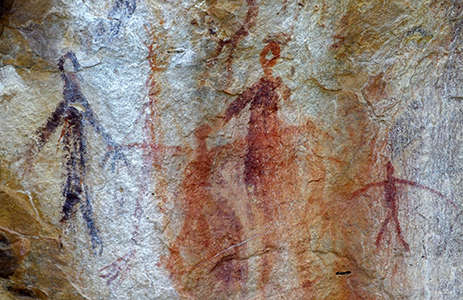
This image shows a very dark ochre figure on the left, with the head outlined but not filled in, the arms hanging down but away from the body, and very large fingers, probably a spirit figure.
To the right of this dark image is a long spirit figure with a rayed head and very long toes on the one foot we can see.
In the centre is what may be an ordinary human in red ochre, with arms held out at right angles to the body. To the right of this is a figure in red and dark red. To the right of this again is the figure with the very long left arm shown above.
Photo: © Leo Dubal
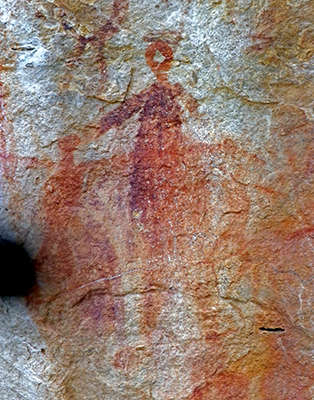
Close up of the central two figures entirely in red and dark red, much faded. A flake of the stone of the wall has come off at the head of the main central figure.
Photo: © Leo Dubal

Dingo in red ochre, without outlining.
The Dingo came to Australia not earlier than 12 000 BP, since there is no evidence of them in Tasmania, which was cut off from the mainland at about that time.
In 1979, an eroding dingo skeleton was excavated by Brown and Gollan (ANU) on the mid-coast of southern New South Wales, dated to 6 000 BP.
Photo: © Leo Dubal
Text: Adapted from Wikipedia
Emu Track Engravings
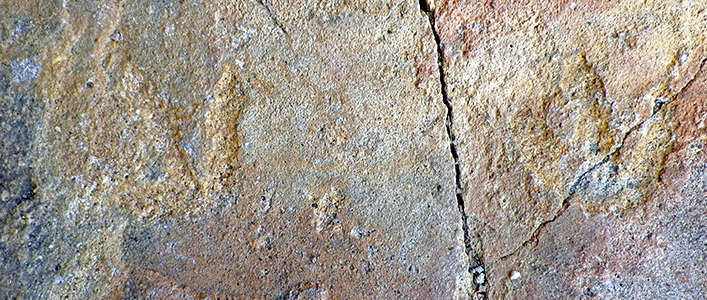
Emu track engravings. These appear to be very old.
Photo: © Leo Dubal
Brady Creek and environs
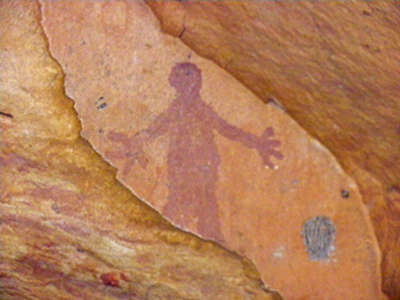
This spirit figure has very fat fingers, and has been completed with lighter spots all over the body. It is near the bed of Brady Creek.
Photo: © Leo Dubal
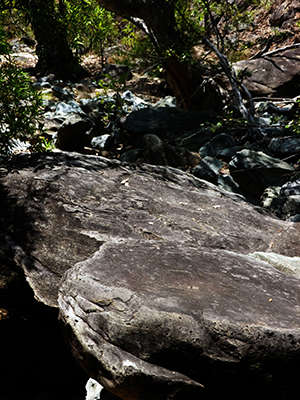
Engraving in the bed of Brady Creek on the rock in the foreground of a man and woman copulating.
Photo: © Leo Dubal
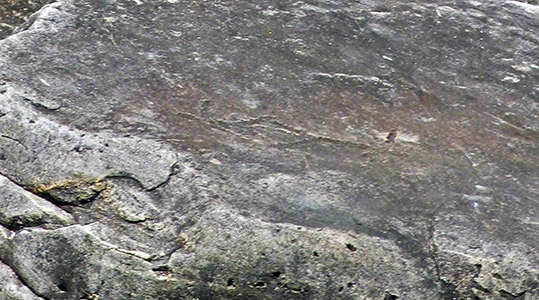
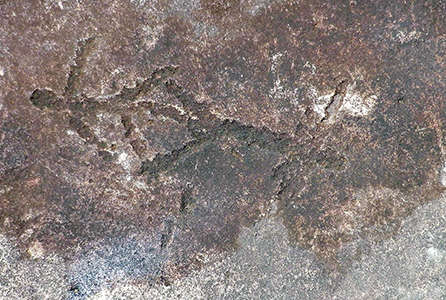
Engraving in the bed of Brady Creek of a man and woman copulating.
This image is almost identical to the painting in the rock shelter above the creek. They are both certainly from the same culture, and may be by the same artist.
Photo: © Leo Dubal
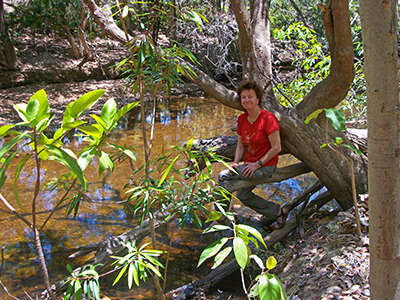
Brady Creek. This would have been a very important resource for fresh, clean water.
Photo: © Leo Dubal
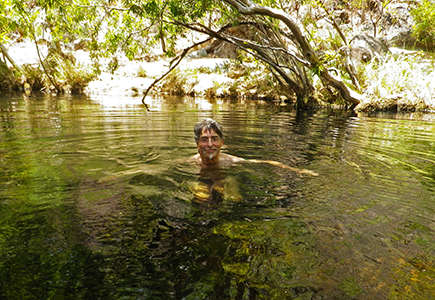

No doubt the artists who painted the pictures enjoyed the pools of Brady Creek to cool off on a hot day just as much as modern visitors!
Photo: © Leo Dubal

Map of some of the sites mentioned.
Photo: supplied by Leo Dubal
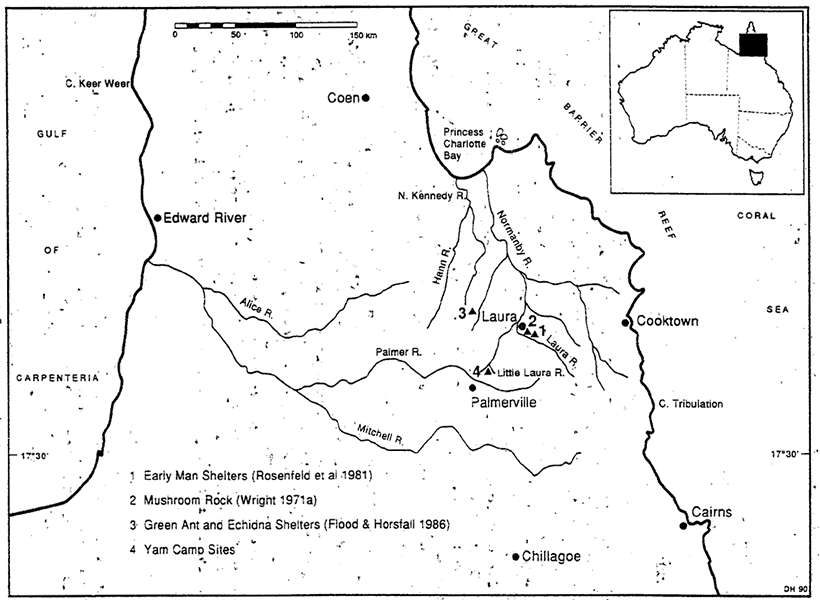
Map of part of Far North Queensland showing the location of the Laura River rock art sites.
Photo: Pearson (1989)
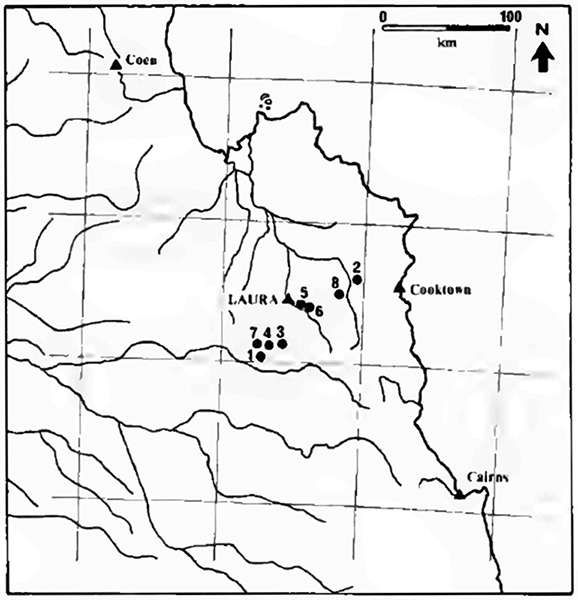
The Laura sandstone belt, showing the location
of some rock art sites.
1 Yam Camp
2 Platform Gallery
3 Magnificent Gallery
4 Sandy Creek
5 Mushroom Rock
6 Early Man
7 Red Bluff
8 Red Horse
Photo and text: David and Chant (1995)
References
- David B., Chant D., 1995: Rock art and regionalisation in north Queensland prehistory, Memoirs of the Queensland Museum, Brisbane 1 August 1995 Volume 37 Part 2 Hamlyn-Harris, Ronald; Queensland Museum
- Pearson W., 1989: A Technological Analysis of Stone Artefacts from Yam Camp Surface Scatter and Rockshelter, S.E- Cape York Peninsula, Queensland Archaeological Research, Vol. 6, December 1989
- Sowerby J., Lear E., 1872: Tortoises, terrapins, and turtles drawn from life, London, Paris, and Frankfort, H. Sotheran, J. Baer & co.
